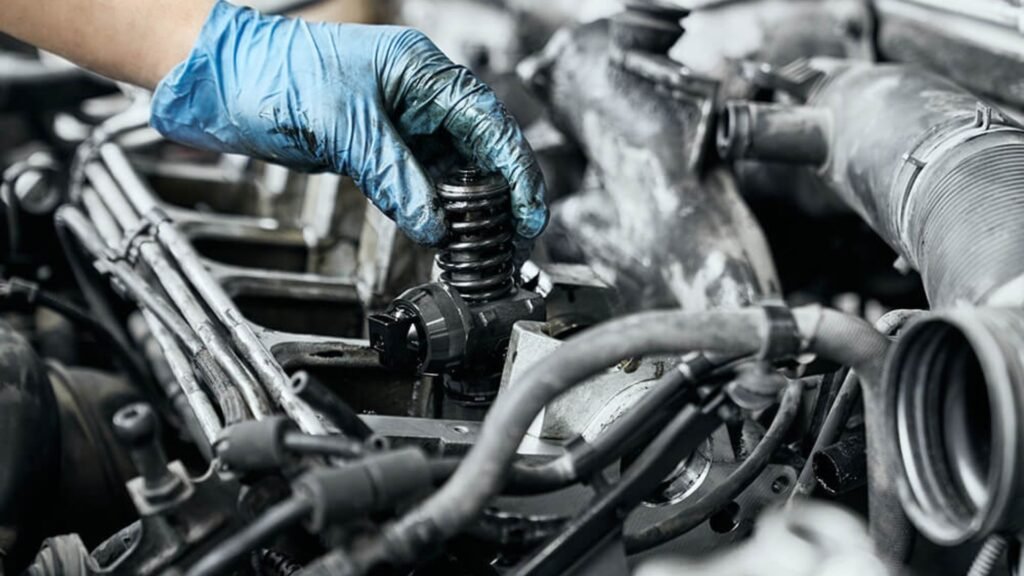Engines are complex machines that can experience various issues over time. Understanding common engine problems and their solutions can help you maintain your vehicle and avoid costly repairs. Here’s a guide to some of the most frequent engine issues and solutions to address them.

1. Engine Misfire
1.1 What is an Engine Misfire?
Overview: An engine misfire occurs when one or more cylinders fail to ignite the air-fuel mixture properly. This can lead to rough running, reduced power, and increased emissions.
Symptoms:
- Rough Idling: Engine shakes or runs unevenly at idle.
- Loss of Power: Reduced acceleration and performance.
- Increased Emissions: Higher levels of exhaust emissions.
Common Causes:
- Faulty Spark Plugs: Worn or dirty spark plugs can cause misfires.
- Bad Ignition Coils: Defective ignition coils may fail to deliver the spark needed for combustion.
- Fuel Injector Problems: Clogged or malfunctioning fuel injectors can disrupt fuel delivery.
Solutions:
- Replace Spark Plugs: Check and replace worn spark plugs as needed.
- Inspect Ignition Coils: Test and replace faulty ignition coils.
- Clean or Replace Fuel Injectors: Clean clogged injectors or replace them if necessary.
2. Overheating
2.1 What Causes Engine Overheating?
Overview: Engine overheating can lead to severe damage if not addressed promptly. It occurs when the engine runs at a temperature higher than the normal operating range.
Symptoms:
- High Temperature Gauge: Temperature gauge reads higher than normal.
- Steam from Engine: Visible steam or smoke coming from the engine bay.
- Loss of Power: Reduced engine performance due to overheating.
Common Causes:
- Coolant Leak: Leaks in the coolant system can reduce cooling efficiency.
- Faulty Thermostat: A malfunctioning thermostat may prevent proper coolant flow.
- Clogged Radiator: A clogged radiator can obstruct coolant flow and lead to overheating.
Solutions:
- Check Coolant Levels: Ensure coolant levels are adequate and top up as needed.
- Inspect for Leaks: Look for and repair any coolant leaks in the system.
- Replace Thermostat: Replace a faulty thermostat to ensure proper temperature regulation.
- Flush Radiator: Clean or flush the radiator to remove any clogs.
3. Oil Leaks
3.1 What Causes Oil Leaks?
Overview: Oil leaks can lead to low oil levels and potential engine damage. Identifying and fixing oil leaks is crucial for engine health.
Symptoms:
- Oil Spots: Puddles or spots of oil under the vehicle.
- Burning Oil Smell: Smell of burning oil inside the vehicle.
- Low Oil Pressure: Warning lights or gauges indicating low oil pressure.
Common Causes:
- Worn Seals: Engine seals and gaskets may wear out and cause leaks.
- Loose Oil Filter: A loose or improperly installed oil filter can lead to leaks.
- Cracked Oil Pan: Damage or cracks in the oil pan can result in oil leaks.
Solutions:
- Replace Seals and Gaskets: Replace worn or damaged seals and gaskets.
- Tighten Oil Filter: Ensure the oil filter is properly tightened and installed.
- Repair or Replace Oil Pan: Fix or replace a damaged oil pan to stop leaks.
4. Poor Fuel Economy
4.1 What Causes Poor Fuel Economy?
Overview: Poor fuel economy means your vehicle consumes more fuel than normal. This can be a sign of underlying engine issues.
Symptoms:
- Frequent Refueling: Increased frequency of refueling compared to usual.
- Decreased Miles Per Gallon (MPG): Lower fuel efficiency than expected.
Common Causes:
- Dirty Air Filter: A clogged air filter can reduce engine efficiency.
- Faulty Oxygen Sensor: A malfunctioning oxygen sensor can affect fuel mixture and economy.
- Underinflated Tires: Low tire pressure can decrease fuel efficiency.
Solutions:
- Replace Air Filter: Check and replace the air filter if it’s dirty.
- Test Oxygen Sensor: Have the oxygen sensor tested and replaced if faulty.
- Check Tire Pressure: Ensure tires are properly inflated to improve fuel efficiency.
5. Check Engine Light
5.1 What Does the Check Engine Light Indicate?
Overview: The check engine light can signal a variety of issues, ranging from minor problems to serious engine faults.
Symptoms:
- Illuminated Warning Light: The check engine light is on or flashing.
- Rough Running: Engine may run roughly or with reduced performance.
Common Causes:
- Loose Gas Cap: A loose or damaged gas cap can trigger the light.
- Emission Control Issues: Problems with the emission control system can cause the light to activate.
- Sensor Failures: Faulty sensors, such as the mass air flow sensor, can trigger the light.
Solutions:
- Check Gas Cap: Ensure the gas cap is tightly secured and replace if necessary.
- Diagnostic Scan: Use an OBD-II scanner to read the error codes and identify the issue.
- Repair Faults: Address the specific problems identified by the diagnostic scan.
6. Hard Starting
6.1 What Causes Hard Starting?
Overview: Hard starting refers to difficulties in starting the engine, which can be caused by several issues.
Symptoms:
- Extended Cranking: Engine takes longer to start than usual.
- Difficulty Starting: Engine struggles to start or fails to start.
Common Causes:
- Weak Battery: A battery with low charge can cause hard starting.
- Fuel Delivery Issues: Problems with the fuel pump or fuel filter can affect starting.
- Ignition System Problems: Faulty ignition components can lead to hard starting.
Solutions:
- Test Battery: Check and replace a weak or failing battery.
- Inspect Fuel System: Check the fuel pump and filter for issues and replace if necessary.
- Check Ignition System: Inspect and replace faulty ignition components as needed.
Conclusion
Understanding common engine issues and solutions is essential for keeping your vehicle in good working condition. From addressing engine misfires and overheating to fixing oil leaks and improving fuel economy, timely maintenance and repairs can prevent minor problems from becoming major issues. Regular inspections, prompt attention to warning signs, and proper upkeep can ensure your engine runs smoothly and reliably, saving you time and money in the long run.




